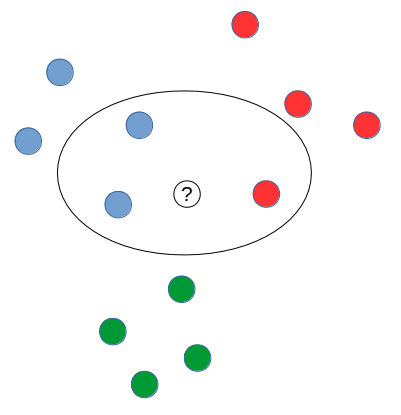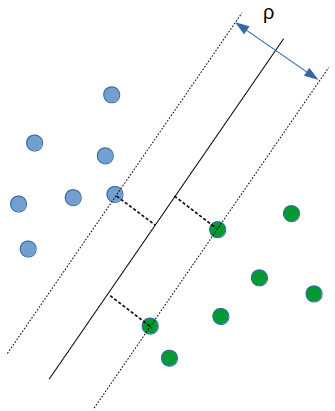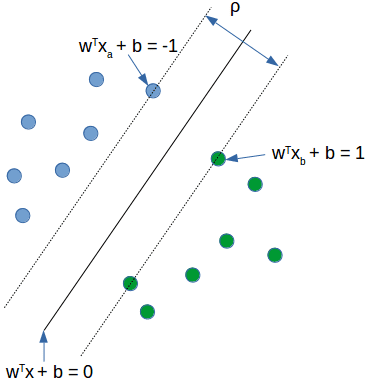WebSearching
March 07, 2017
課本: Introduction to Information Retrieval
CH8 Evaluation in information retrival
評量 search engine 好壞
- 搜到的 index
- 搜尋速度
- 二氧化碳排放量
- 和搜尋相關程度
相關程度
- benchmark 資料集
- benchmark queries(問句)
- 文章是否相關的標記(ground truths)
queries 和 information need 有落差 想找的東西,不會下 key word
Precision (P)
Precision =
Recall (R)
Recall =
| Relevant | Nonrelevent | |
|---|---|---|
| Retrieved | true positive(tp) | false positive(fp) |
| Not retrieved | false negatives(fn) | true negatives(tn) |
true positive(tp) 機器判斷+且為真
false positive(fp)機器判斷+但是是假
false negatives(fn) 機器判斷-但判斷錯
true negatives(tn) 機器判斷-且判斷對
P =
R =
Accuracy vs Precision
accuracy =
accuracy 不適合用在 information retrieval, 因為通常 Nonrelevant 會非常的大,tn 項非常大除分母 fn 和 tn 都非常大結果會趨近於 1,所以才用 Precision 和 Recall 作為依據
調和平均數(harmonic mean)
H =
Precision/Recall Tradoff
使用調和平均數計算 Precision 和 Recall 的 Tradoff
量測的數值稱做 F measure,α和 1-α分別為 P 和 R 的權重,一般是取α=0.5
(P 和 R 重要程度相同)
F = where
Ranked Evalution
P,R,F 都是 unordered(沒有等級)
一個 query 會有一個 Precision/Recall 圖
使用內插法(interpolated)可以得到一張較平滑的 P-R 圖
(和機器學習 ROC curve 相似)
P-R curve 的面積越大效能越佳(代表 Precision 掉越慢)
內插法
r 代表 recall, 作法是從目前往後找最高的點向前填平,並重新畫 P-R 圖
Mean Average Precision(MAP)
第一個 sum 算 query 平均
第二個 sum 算 precision 平均
Precision at k
第 k 個搜索結果的 Precision
R-Precision
文件中總共有 R 篇相關文章,以 R 作為 cut-off,計算 Precision
e.g. 總共有 100 篇文章,其中 10 篇是相關的
且搜尋結果是:RNRNN RRNNN RNNRR …
R=10(只看 RNRNN RRNNN)計算 Precision
R-Precision = 0.4
Normalized Discounted Cumulative Gain(NDCG)
作者:Kalervo Jarvelin, Jaana Kekalainen(2002)
用來衡量 ranking quality
e.g.
G = <3,2,3,0,0,1,2,2,3,0,…>
G 表示一個搜索的結果(3 高度相關, 0 沒關係)
步驟:
-
Cumulative Gain(CG)
目前項+=前一項(做成一個遞增的函數) CG’=<3,5,8,8,8,9,11,13,16,16,…>
-
Discounted Cumulative Gain(DCG)
DCG’=<3,5,6.89,6.89,6.89,7.28,7.99,8.66,9.61,9.61,…> if b=2 i 代表排名,對排名做懲罰(除 log2 i),排名越後面懲罰越重 代表如果搜尋的結果很差,和理想的排序分數會相差很多 -
Normalized Discounted Cumulative Gain(NDCG)
理想的搜索結果 I=<3,3,3,2,2,2,1,1,1,1,0,0,0,…>(高度相關的排越前面)
理想搜索結果 DCGI=<3,6,7.89,8.89,9.75,10.52,10.88,11.21,…>
nDCGn =
NDCG=<1,0.83,0.87,0.77,0.70,0.69,0.73,0.77,…>
benchmark 資料集
- Cranfield
- TREC(nist.gov)
Ad-hoc 資料集(1992-1999) - GOV2 2500 萬篇文章
- NICIR cross-language IR
- Cross Language Evaluation
- REUTERS
標記資料準則
Kappa measure
標記資料是否一致的衡量標準,若標記不一致資料中就沒有 truth
Kappa 計算公式
搜尋結果的呈現 Result Summaries
- 搜尋結果呈現:10 blue link
- 搜尋結果下方文字說明分為 Static 和 Dynamic Static:固定抽前 50 個字 Dynamic:利用 nlp 技術,根據搜索關鍵字動態做變化
- quicklinks
底下多的連結
CH6 Model
- Vector Space Model
- Probabilistic Information Retrieval
|Empirical IR | Model-based IR| |暴力法|有理論模型| |heuristic|數學假設| |難推廣到其他問題|容易推廣到其他問題|
IR model 歷史
- 1960
第一個機率模型 - 1970
vector space model(75)
classic probabilistic model(76) - 1980
non-class logic model(86) - 1990
TREC benchmark
BM25/Okapi(94)
google 成立(96)
Language model(98) - 2000
Axiomatic model(04)
Markov Random Field(05)
Learning to rank(05)
Vector space
|Vocabulary|V = { }|
|Query|q =|
|Document 文章||
|Collection 文章集合|C = { }|
|R(q) query 的集合|R(q) ⊂ C|
目標是找到近似 query 的集合
策略:
- Document select
挑文件如果是相關就收到集合
absolute relevance(系統必須決定是相關還是不相關) - Document ranking
query 的結果>threshold 就收進去
relative relevance(不必是 1 或 0,相近到一定程度就收進集合)
Probability Ranking Principle(PRP)
Robertson (1977)
相似度量測函數 f 滿足,
f()值越大表示有越大的機率越相似
Relevance 流派
- Similarity 相似度
Vector space model(Salton et al,75) - Probability of relevance 機率模型
Classical probaility Model(Robertson&Sparck Jones,76)
Learning to Rank(Joachims,02, Berges et al,05) - Probability inference 機率推論
Vector Space Model(VSM)
將 query 和 document 表示成向量形式(similar representation)
假設 Relevance(d,q) = similar(d,q)
利用 cosine 算相似度(1 ~ -1)
high dimension(index 的維度通常在 10 萬左右)
good dimension -> orthogonal
(好的維度切割應該是維度間彼此獨立(orthogonal),
但是通常很困難,例如 nccu 後面接 university 的機率很高)
VSM 優點: Empirically effective,直觀, 實作容易
VectorSpace 範例程式
Building a Vector Space Search Engine in Python
大致步驟
- 將所有文章使用 join()成為一個 string 包含所有文章內容
- 做 string clean 去除
.,多餘空白,並轉為小寫 -
將 clean 好的 string 利用空白切分成 words array,丟到Porter stem(去除字尾)
Porter Stemming Algorithm 作者:Martin Porter(2006)
- 刪除重複的 word,使用 set 讓出現的 word 唯一
- 得到所有整理完的 words,做成 index(將每個 word 編號),類似字典的概念
- 將每篇文章分別建立自己的 vector,並統計每個 word 出現的次數(term frequecy)
- 將輸入的 query 做成 vector
- 利用兩個向量做 cosine 計算相關程度
相似度計算
-
Cosine Similarity
cosine =
-
Jaccard Similarity
相似度 =
TF-IDF Weighting
- TF(Term Frequency)
word count,單純統計字數出現頻率 - IDF(Inverse Document Frequency)(反向的 TF)
字的獨特性,如果某些字在很多篇文章出現次數都很高(例如:the,a,to,…)
IDF 值就會很低(沒有鑑別度)
IDF(t) = 1 + log(n/k) (n:篇數,k:字出現次數)
例如文章總數是 1000(n=1000),所有文章都有出現 cat(k=1000),
IDF = 1 + log(1000/1000) = 1
如果只有 1 篇文章有出現 cat,
IDF = 1 + log(1000/1) = 4
TF-IDF 計算方法:
weight(t,d) = TF(t,d) * IDF(t)
TF-IDF 範例程式
Tutorial: Finding Important Words in Text Using TF-IDF
Ch11 Probabilistic Information Retrieval
Probability theory
- Joint probability
- Conditional probability
probability of A given that event B occurred. - Chain rule
- Partition rule
有兩個甕第一個甕放 1 個黑球 2 個白球,第二個甕放 1 個黑球 3 個白球
事件 A 是選到第一個甕,事件 B 是選到白球
在選到第一個甕的情況下拿到白球
Bayes’ Rule
from chain rule:
P(A) : 事前機率(prior probability)
P(A|B) : 事後機率(postior probability)
P(B|A) : likelihood
The term likelihood is just a synonym of probability.Odds
an event provide a kind of multiplier for how probabilities change.
Probability of Relevance
-
Random variables:
- query Q
- document D
- relevance R ∈ {0,1}
(1:相關,0:不相關)
- Goal: P(R=1|Q,D) to rank relevant
利用 query 和 document 相似度的機率做排名
Refining P(R=1|Q,D) Methods
-
Conditional Models(Discriminative Models)
- 利用各種方法找出機率 P = f(x)
- 利用資料訓練參數
- 利用 model 去排列未知的 document
e.g. Learning to rank,類神經網路,…
-
Generative Models
- compute the odd of O(R=1|Q,D) using Bayes’ rules
先找出資料的分佈再做預測 - How to define P(Q,D|R)
- Document generation: P(Q,D|R)=P(D|Q,R)P(Q|R)
query 放到條件 (e.g RSJ model) - Query generation: P(Q,D|R)=P(Q|D,R)P(D|R)
document 放到條件 (e.g language model)
- compute the odd of O(R=1|Q,D) using Bayes’ rules
RSJ Model (Binary Independence Model)
利用Odd值做 ranking 的依據:
對 document ranking 沒有影響,視為常數
將 document 拆成多個獨立的 document term 連乘積,且
(2)代入(1)可以整理出(3)
將 document term 分為出現或是不出現,(3)→(4)
表示 term 出現在 document 且和 query 相關的機率
表示 term 出現在 doucment 且和 query 不相關的機率
假設(假設可以做改變)
意思是沒出現在 query 的 term 就不用考慮,只考慮
左邊連乘積表示 query term found in document
右邊連乘積表示 query term not found in document
右邊連乘積乘上 , 所以所邊必須要除才會相等
右邊連乘積是 query not found in document
概念大概是將 query found in document 也計算進去,
不管有沒有出現在 document 都乘
整理後右邊連乘積的範圍就會和 document 無關
在對 document ranking 時就視為常數
取 log 後就得到 Retrieval Status Value(RSV),
log 是 monotonic function 不會改變 ranking 順序
RSJ Model:No Relevance Info
如果沒有給 relevance judgements,
- assume to be a constant
- Estimate by assume all documents to be non-relevant
1979 Croft&Harper
N: number of documents in collection
: number of documents in which term occurs
只看在 document 中和 query 相關的字,並加總每個字算出來的值
RSJ Model: with Relevance Info
- Maximum Lieklihood Estimate(MLE)
- Maximum A Posterior(MAP)
RSJ model 的 performance 還遠比不上 vector space model
Improving RSJ
- adding TF
- adding Doc.length
- query TF
改善後的最終公式稱作BM25
CH12 Language models for information retrieval
unigram language model
每個 word 只有單一的狀態,可以建立一個 table 放每個 word 對應到的機率
一個 string 出現的機率就是每個 word 的機率連乘積
Language model 應用:語音系統的語言校正
Language model 屬於 query generation process
每一篇 document 視為一個 language model
ranking 的計算是根據 P(Q|D)
計算 P(Q|D)
|q|: length of query
: query 的第 k 個位置的 token
: term frequency of t in q
估計參數
hat符號表示估計值的意思smooth the estimates to avoid zeros
避免 0 產生,相乘後結果很差
smooth 方法
-
Mixture model
: the collection model
的設定好壞會影響效能e.g.
Collection = {}
: Jack wants to play game
: Tom is cat
query q: Tom game
P(d|) = [(0/5 + 1/8)/2][(1/5 + 1/8)/2] 0.0101
P(d|) = [(1/3 + 1/8)/2][(0/3 + 1/8)/2] 0.0143
rank
Text Generation with Unigram LM
- sampling
由一個特定主題的 model,裡面會有各個字出現的機率(每一個 model 會有一個 distribution,機率分佈),取出一些機率較高的字可以形成 document - estimation
拿到一個 document,預估出 model
CH13 Text Classification and Naive Bayes
- Text Classification
- Naive Bayes
- Naive Bayes Theory
- Evaluation of Text Classification
Text Classification
standard supervised
- Pre-define categories and lebel document
- classify new documents
分類的方法
- 人工判斷 準確但成本高
- Rule-based
很多 if/else 的 rule,看到王建民就分類到體育新聞
e.g. google Alert -
Statistical/Probabilistic
- Instance-based classifiers
e.g. kNN - Discriminative classifiers
學習出分隔的形式(一條線,一棵樹)
資料少容易 overfit
e.g. Decision tree,Neural Network - Generative classifier
利用大量資料學習出分佈模型(mean,varience)
e.g Naive Bayes
- Instance-based classifiers
K-Nearest Neighbor Classifier(KNN)
Keep all train data
優點:不需要 training(每一個點都記錄下來)
缺點:不能做大量資料
Naive Bayes Classifier
arg max_c 找到一個 c(類別)使 P(c|d)最大 避免 under flow -> 取 log 連乘變成連加
機率會有零產生->避免這種情形全部機率做加 1
估計事前機率 是這個類別的機率和不是這個類別的機率 估計完這些係數 training 就結束
P(c|d) 給 document 判斷是哪個類別 P(c|d) = P(c)P(d|c)/P(d) 分母不考慮,和分類無關 且分子越大越好 P(d|c)可以拆成多個 Term 的連乘積 且假設每個字之間獨立
Feture Selection
- Reduces training time 挑特定的字訓練模型
Two idea
- Mutual information 計算字的交互作用,每一個字會有一個值,找 gap 最大的切開,拿比較相關的字做訓練
- CHI-Square statistic 用機率方法計算,算出機率高的就拿去做訓練資料
Evaluations 測試資料和 training data 不能有 overlapping
CH14 Vector Space Classification
Vector Space Classification 基本假設
- 資料如果同類會形成一個連續的空間
- 資料如果不同類別,所形成的空間不會有 overlap
Rocchio classification(Nearest centroid classifier)
將資料表示成向量形式, 並將各類別的資料計算出重心(所有向量加總取平均), 利用distance計算相似度 計算的成本很低,但效果不太好(比naive bayes差)主要是沒有處理:
- nonconvex
- multimodal classes
應用:
- 1970 年 SMART 搜索系統中,應用在 relevance feedback
k Nearest Neighbors(kNN) classification
> 要分類的點根據最近的k個鄰居做投票決定k = 1 過於 sensitive,太容易由某一類變成另外一類
k 太大結果過於模糊
k 通常選擇奇數(3,5,7),通常使用 heuristic 來決定 k 值
計算相似度:
- Euclidean distance
- Hamming distance (binary instance)
- cosine similarity of tfidf
特色:
- 沒有任何學習
- 如果資料集很大,準確率非常高,資料集小可能就不會很準
- 大致上準確率會較 Naive Bayes 和 Rocchio 高
- Simple, expensive at test time, high variance, non-linear
Linear classification
> 想法是將所有的資料分為兩類,用一些公式計算出來的值大於一個門檻值分為一類,小於門檻值分到另一類線性分類器代表一個分界面,在一維代表一個點、二維代表一條線、三維代表一個平面
找到分界面的演算法分為兩類
-
Simple learning algorithms
透過學習資料,學出分界面的參數- Naive Bayes,Rocchio,kNN
-
Iterative algorithms
- Support vector machines,Perceptron
Linear Classifier 算是多個方法的集大成
e.g. Naive Bayes,Perceptron,Rocchio,Logistic regression,Support vector machines(with linear kernel),Linear regression with threshold
Bias-Variance Tradeoff
一種量測分類方法的指標
- Bias
分類的結果和真實結果差距多少
差距越大 Bisa 越高 - Variance
比較每次猜出來的結果差異會不會很大
理想情形是 low Bias, low Variance
Ch15 Support Vector Machines and Machine Learning on Documents
在 linear classification 中,分界線有無限多條,SVM 可以在這些線中找到一條最佳的線,而這條線只會由少數的點來形成。這些點是由分割上最困難的點所成的集合,集合稱作 support vector
要怎麼找到最佳的分割界面(hyperplane)
SVM 是從所有可能的分割界面中找到 geometric margin 最大的作為分割界面
Geometric Margin
訓練出來的線,兩端碰到最近的 support vector 中的點所為成的區域
- w: hyperplane normal vector
- : data point i
- : class of data point (+1 or -1)
- classifier: f() = sign( + b) //b: bias
- Define functional margin of is
如果分到 1 類別帶入分類器會1
分到-1 類別帶入分類器會-1
quadratic optimization problem
找到 w 和 b 使最大
較好的表示方法
要讓最大,最小化
找到 w 和 b 使最小
希望 + b)同號
也就是希望分類結果和帶入分類器結果是同號
dual problem
每一個線性規劃的問題(primary problem)都有一個對映的線性規劃問題(dual problem),解決 dual problem 就可以得到原來問題的解
解決上面問題的 dual problem
Lagrange multiplier
找到使最大
solution
大多數的點代表不重要的點,而非零的代表為 support vector
分類的 function
soft margin classification 允許某些點可以分錯 (w) 1/2||w|| + C slack C 越小越可以容錯 因為希望(w) 出來的值可以越小越好
Non-linear SVMs
用一條線分不開的情形, svm 提供 kernel function 的概念,將點 map 到更高維的空間中,就有機會能夠分割
kernel function
透過 kernel function 可以知道高維空間的內積值
Common kernels
- Linear
- Polynomial
- Radial basis function(infinite dimensional space)
Ch16 Flat clustering
Classification 分類 vs. Clustering 分群
- supervised learning
- Unsupervised learning 資料沒有 label,沒有正確答案
- reinforcement learning
Flat vs. Hierarchical clustering
-
Flat
- Hard clustering
一個東西就只能分到一類
e.g. K-means - Soft clustering
比較偏向使用機率分群
- Hard clustering
一個東西就只能分到一類
- Hiearchical clustering
希望分群完後是一種階層架構
K-means
- Each cluster in K-means is defined by a centroid
Method
- reassignment of vector
- recomputation of centroids
- init 隨機給重心點
- reassign
- recomputation of centroids
什麼時候收斂? RSS(residual sum of squares) 每次的 centroid 差值小於某個值就停止
缺點是 initial 的點很糟結果會不好和 k 怎麼決定
time complexity O(IKNM)
Evaluation
- Internal criteria RSS 的評估
-
External criteria goal base,必須要知道正確答案
- Purity 必須要有正確答案,並和分出的結果做比較
怎麼決定 k 值
- 外部資訊
- 從 1 開始慢慢加上去,並且計算 criteria 是否有增加
Ch21 Link Analysis
- Anchor Text
- Citation Analysis
- PageRank
- HITS: Hub & Authorties
Citation Analysis
Citation frequency can be used to meature impact
PageRank
model behind Random walk 在所有網頁上隨機走動,且根據 link 連到其他網頁 到穩定狀態(steady state)後,計算停留在每個 page 的機率 PageRank = long-term visit rate
將網頁連結的關係使用矩陣來存 Dead end,如果有一些網頁指到同一個網頁如果之後就跳不出去會有 not well define 的問題 teleporting 解決這個問題,給一個很低的機率讓所有 0 的網頁都有機會跳到別的網頁, 類似 smoothing, 每個點會有一個機率,且乘上矩陣一次會走一步 那一直走下去會到收斂狀態()
P is transifer matrix
Power method -> 一直乘 P,直到向量收斂
HITS & Authorities
- Hub 像是入口網站,有很多連出去的連結(out link)
- Authorities 網站內的資料是屬於比較官方的網站 資料屬於比較權威(就是多的 link 指向的網頁)
不停的迭代
A 代表相鄰矩陣 a 的初始值()在第一輪都設定為一樣



